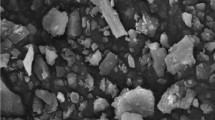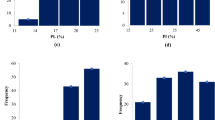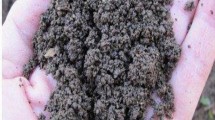Abstract
This study aims to improve the unconfined compressive strength of soils using additives as well as by predicting the strength behavior of stabilized soils using two artificial-intelligence-based models. The soils used in this study are stabilized using various combinations of cement, lime, and rice husk ash. To predict the results of unconfined compressive strength tests conducted on soils, a comprehensive laboratory dataset comprising 137 soil specimens treated with different combinations of cement, lime, and rice husk ash is used. Two artificial-intelligence-based models including artificial neural networks and support vector machines are used comparatively to predict the strength characteristics of soils treated with cement, lime, and rice husk ash under different conditions. The suggested models predicted the unconfined compressive strength of soils accurately and can be introduced as reliable predictive models in geotechnical engineering. This study demonstrates the better performance of support vector machines in predicting the strength of the investigated soils compared with artificial neural networks. The type of kernel function used in support vector machine models contributed positively to the performance of the proposed models. Moreover, based on sensitivity analysis results, it is discovered that cement and lime contents impose more prominent effects on the unconfined compressive strength values of the investigated soils compared with the other parameters.
Similar content being viewed by others
References
Cristelo N, Glendinning S, Fernandes L, Pinto T A. Effects of alkaline activated fly ash and Portland cement on soft soil stabilization. Acta Geotechnica, 2013, 8(4): 395–405
Anwar Hossain K M. Stabilized soils incorporating combinations of rice husk ash and cement kiln dust. Journal of Materials in Civil Engineering, 2011, 23(9): 1320–1327
Muthadhi A, Kothandaraman S. Optimum production conditions for reactive rice husk ash. Materials and Structures, 2010, 43(9): 1303–1315
Bagheri Y, Ahmad F, Ismail M A M. Strength and mechanical behavior of soil-cement-lime-rice husk ash (Soil-CLR) mixture. Materials and Structures, 2014, 47(1–2): 55–66
Shahin M A, Maier H R, Jaksa M B. Data division for developing neural networks applied to geotechnical engineering. Journal of Computing in Civil Engineering, 2004, 18(2): 105–114
Narendra B S, Sivapullaiah P V, Suresh S, Omkar S N. Prediction of unconfined compressive strength of soft grounds using computational intelligence techniques: A comparative study. Computers and Geotechnics, 2006, 33(3): 196–208
Kalkan E, Akbulut S, Tortum A, Celik A. Prediction of the unconfined compressive strength of compacted granular soils by using inference systems. Environmental Geology (Berlin), 2009, 58(7): 1429–1440
Suman S, Mahamaya M, Das S K. Prediction of maximum dry density and unconfined compressive strength of cement stabilized soil using artificial intelligence techniques. International Journal of Geosynthetics and Ground Engineering, 2016, 2: 1–11
He S, Li J. Modeling nonlinear elastic behavior of reinforced soil using artificial neural networks. Applied Soft Computing, 2009, 9(3): 954–961
Gunaydin O, Gokoglu A, Fener M. Prediction of artificial soil’s unconfined compression strength test using statistical analyses and artificial neural networks. Advances in Engineering Software, 2010, 41(9): 1115–1123
Shrestha R. Deep soil mixing and predictive neural network models for strength prediction. Dissertation for the Doctoral Degree. Cambridge: University of Cambridge, 2012
Wang O, Al-Tabbaa A. Preliminary model development for predicting strength and stiffness of cement-stabilized soils using artificial neural networks. In: ASCE International Workshop on Computing in Civil Engineering. Los Angeles, CA, 2013, 299–306
Park H I, Kim Y T. Prediction of strength of reinforced lightweight soil using an artificial neural network. Engineering Computations, 2011, 28(5): 600–615
Mozumder R, Laskar A I. Prediction of unconfined compressive strength of geopolymer stabilized clayey soil using artificial neural network. Computers and Geotechnics, 2015, 69: 291–300
Güllü H, Fedakar H I. On the prediction of unconfined compressive strength of silty soil stabilized with bottom ash, jute and steel fibers via artificial intelligence. Geomechanics and Engineering, 2017, 12(3): 441–464
Ghorbani A, Hasanzadehshooiili H. Prediction of UCS and CBR of microsilica-lime stabilized sulfate silty sand using ANN and EPR models: Application to the deep soil mixing. Soil and Foundation, 2018, 58(1): 34–49
Erzin Y, Ecemis N. The use of neural networks for CPT-based liquefaction screening. Bulletin of Engineering Geology and the Environment, 2015, 74(1): 103–116
Mozumder R A, Laskar A I, Hussain M. Empirical approach for strength prediction of geopolymer stabilized clayey soil using support vector machines. Construction & Building Materials, 2017, 132: 412–424
Wang J, Xing Y, Cheng L, Qin F, Ma T. The prediction of mechanical properties of cement soil based on PSO-SVM. In: International Conference on Computational Intelligence and Software Engineering. Wuhan: IEEE, 2010, 10: 1–4
Shi X, Liu Q, Lv X. Application of SVM In prediction the strength of cement stabilized soil. Applied Mechanics and Materials, 2012, 160: 313–317
Tinoco J, Gomes Correia A, Cortez P. Support vector machines applied to uniaxial compressive strength prediction of jet grouting columns. Computers and Geotechnics, 2014, 55: 132–140
Ceryan N. Application of support vector machines and relevance vector machines in predicting uniaxial compressive strength of volcanic rocks. Journal of African Earth Sciences, 2014, 100: 634–644
Zhao H. Slope reliability analysis using a support vector machine. Computers and Geotechnics, 2008, 35(3): 459–467
Kordjazi A, Pooya Nejad F, Jaksa M B. Prediction of ultimate axial load-carrying capacity of piles using a support vector machine based on CPT data. Computers and Geotechnics, 2014, 55: 91–102
Singh V K, Kumar D, Kashyap P S, Singh P K, Kumar A, Singh S K. Modelling of soil permeability using different data driven algorithms based on physical properties of soil. Journal of Hydrology (Amsterdam), 2019, 580: 124223
Xue X, Yang X. Seismic liquefaction potential assessed by support vector machines approaches. Bulletin of Engineering Geology and the Environment, 2016, 75(1): 153–162
Hoang N C, Bui D T. Predicting earthquake-induced soil liquefaction based on a hybridization of kernel Fisher discriminant analysis and a least squares support vector machine: A multi-dataset study. Bulletin of Engineering Geology and the Environment, 2018, 77(1): 191–204
Rahbarzare A, Azadi M. Improving prediction of soil liquefaction using hybrid optimization algorithms and a fuzzy support vector machine. Bulletin of Engineering Geology and the Environment, 2019, 78(7): 4977–4987
Haykin S S. Neural Networks: A Comprehensive Foundation. New York: Prentice Hall, ISBN 0132733501. OCLC 38908586. 1999
Anitescu C, Atroshchenko E, Alajlan N, Rabczuk T. Artificial Neural Network Methods for the solution of second order boundary value problems. Computers, Materials & Continua, 2019, 59(1): 345–359
Guo H, Zhuang X, Rabczuk T. A deep collocation method for the bending analysis of Kirchhoff plate. Computers, Materials & Continua, 2019, 59(2): 433–456
Aladag C H, Egrioglu E, Gunay S, Basaran M A. Improving weighted information criterion by using optimization. Journal of Computational and Applied Mathematics, 2010, 233(10): 2683–2687
Vapnik V N, Golowich S E, Smola A. Support vector method for function approximation, regression estimation and signal processing. In: NIPS’96: Proceedings of the 9th International Conference on Neural Information Processing Systems. San Mateo, CA: Morgan Kaufmann, 1996
Kohestani V R, Hassanlourad M. Modeling the mechanical behavior of carbonate sands using artificial neural networks and support vector machines. International Journal of Geomechanics, 2016, 16(1): 04015038
Smola A J, Scholkopf B. A Tutorial on Support Vector Regression. Report No. NC2-TR-1998-030, Neuro COLT2 Technical Report Series. 1998
Hsu C W, Chang C C, Lin C J. A Practical Guide to Support Vector Classification. Technical report. Taipei, China: Taiwan University, 2016
Cristianini N, Shawe-Taylor J. An Introduction to Support Vector Machines and Other Kernel Based Learning Methods. London: Cambridge University, 2000
Goh A T, Goh S. Support vector machines: Their use in geotechnical engineering as illustrated using seismic liquefaction data. Computers and Geotechnics, 2007, 34(5): 410–421
Samui P. Support vector machine applied to settlement of shallow foundations on cohesionless soils. Computers and Geotechnics, 2008, 35(3): 419–427
Al-Anazi A F, Gates I D. Support vector regression to predict porosity and permeability: Effect of sample size. Computers & Geosciences, 2012, 39: 64–76
Tran K Q, Satomi T, Takahashi H. Tensile behaviors of natural fiber and cement reinforced soil subjected to direct tensile test. Journal of Building Engineering 2019, 24: 1–10
Acknowledgements
The authors of this paper would like to acknowledge the support provided (No. 981861) by Golestan University.
Author information
Authors and Affiliations
Corresponding author
Rights and permissions
About this article
Cite this article
Tabarsa, A., Latifi, N., Osouli, A. et al. Unconfined compressive strength prediction of soils stabilized using artificial neural networks and support vector machines. Front. Struct. Civ. Eng. 15, 520–536 (2021). https://doi.org/10.1007/s11709-021-0689-9
Received:
Accepted:
Published:
Issue Date:
DOI: https://doi.org/10.1007/s11709-021-0689-9




